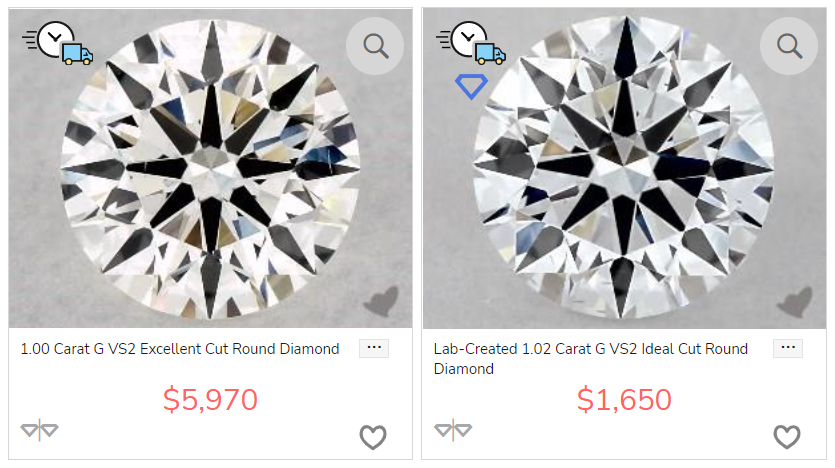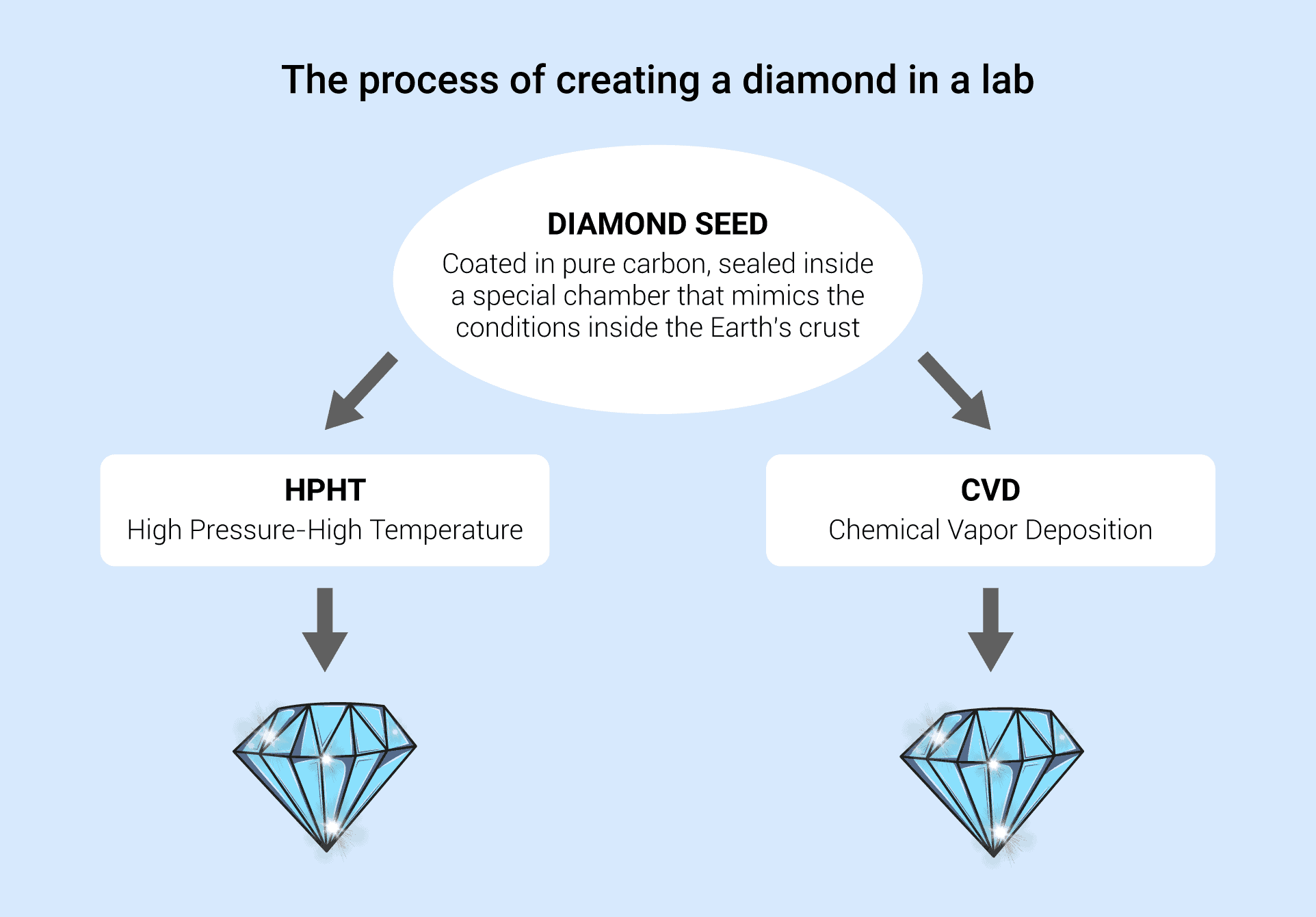A lab-created diamond is “grown” inside a lab using cutting-edge technology that replicates the natural diamond growing process. The result is a man-made diamond that is chemically, physically, and optically the same as those grown beneath the Earth’s surface.
Diamonds have captivated our imaginations for centuries, symbolizing love, luxury, and eternal beauty. Traditionally, these prized gemstones have been mined from the earth, but in recent years, a new alternative has emerged: lab-grown diamonds. These diamonds are created in a controlled laboratory environment, mimicking the natural diamond formation process. In this blog post, we will explore all aspects of lab-grown diamonds, from their creation to their environmental impact and ethical considerations.
What are Lab-grown Diamonds?
Lab-Grown Diamonds are just like test tube babies grown from a single seed of Diamond under the same heat and pressure as in the crust of mother earth. They are ecologically friendly as they do not scar the earth with mining. Since they avoid the stigma of blood diamonds there has been a worldwide acceptance of this category. And, most importantly, they are more uniform, yet cheaper than earth-mined diamonds.
Lab-grown(also known as lab-created diamonds, man-made, engineered, and) are grown in highly controlled laboratory environments. They are using advanced technological processes that duplicate the conditions under which diamonds naturally develop when they form in the mantle, beneath the Earth’s crust. These lab created diamonds consist of actual carbon atoms arranged in the characteristic diamond crystal structure. Since they are made of the same material as natural diamonds, they exhibit the same optical and chemical properties.
Is it a real diamond?
Yes, it is a real diamond, even the most sophisticated gem laboratories certify it as a diamond. The only difference is the origin of these diamonds, instead of being mined from the earth, they are grown in a controlled environment in a lab.
Our lab-created diamonds are readily available in a variety of colorless ranges. Our lab-created diamonds are also available in fancy colors that are considered very rare in nature, including popular hues of vivid yellow. Fancy-colored lab-created diamonds sell at comparatively reasonable prices compared to their natural-colored diamond counterparts.
How are Lab-grown diamonds created?
Before we talk about how lab-created diamonds are made, it’s important to understand how mined diamonds are formed. The processes are extremely similar – only one happens naturally while the other occurs in a lab
Mined Diamonds Geologists believe that diamonds formed deep within the Earth between 1 billion to 3 billion years ago. While they don’t know exactly how those diamonds came to be, they believe the process starts with carbon dioxide that is buried roughly 100 miles beneath the Earth’s surface.
The carbon dioxide is exposed to heat more than 2,200 degrees Fahrenheit and put under extreme pressure of roughly 727,000 pounds per square inch. The diamonds are then transported from deep within the Earth’s core to the surface by way of deep volcanic explosions.
Lab-grown Diamonds Processes
There are two processes labs use to grow diamonds – High Pressure-High Temperature (HPHT) and Chemical Vapor Deposition (CVD).
- HPHT diamonds are made using one of three manufacturing processes: a belt press, the cubic press, and the split-sphere (BARS) press. All of these processes create an environment of extremely high pressure and temperature conducive to diamond growth.
- An HPHT diamond begins as a small diamond seed that is placed into carbon. Using one of the manufacturing processes above, the seed is exposed to temperatures of about 1500 degrees Celsius and pressurized to approximately 1.5 million pounds per square inch.
- The pure carbon melts and starts to form a diamond around the starter seed. It is then carefully cooled to form a pure carbon diamond.
- A CVD diamond begins as a thin slice of diamond seed, which is often an HPHT-produced diamond. The diamond seed is placed in a sealed chamber and heated to around 800 degrees Celsius.
- The chamber is filled with a carbon rich-gas, like Methane, and other gases. The gases are ionized into plasma using technology similar to that of microwaves or lasers. The ionization breaks the molecular bonds in the gases, and the pure carbon adheres to the diamond seed and slowly crystallizes.
How are lab-grown diamonds certified and graded?
Lab-created diamonds are graded and certified using the same process as mined diamonds.
Diamonds are sent to a gem lab that specializes in grading diamonds. The majority of these labs grade using the 4c’s (cut, clarity, color, and carat — more on those later), however, a select few use their own criteria.
Benefits of Lab-grown diamonds
Less expensive
The price of lab-created diamonds tends to be less than mined diamonds.
Mined diamonds and lab-created diamonds have the exact same costs when it comes to cutting, polishing, and inspection. However, up to that point, the costs and processes are very different.
Mined diamonds have a long supply chain. Getting a diamond from its raw form to a retail-ready gemstone requires miners, distributors, cutters, polishers, jewelry manufacturers, and retailers.
On the flip side, the lab-created diamond supply chain is much shorter by skipping the mining process. To put it simply, a lab-created diamond touches fewer hands, making it ultimately less expensive.
Environmentally Kind
As with the mining of any natural resource, diamond mining has a significant impact on the environment. To be fair, diamond mining companies are fully aware of that impact and have taken steps to try to minimize the effect they have on the ecosystems around them.
However, lab-created diamonds are inherently and significantly less detrimental to the environment as it takes considerably less energy to grow a diamond in a lab than it does to dig it out of the ground. In fact, it is actually in the interest of the growers to minimize the amount of energy they use in the process to save money and decrease their costs.
Lab-grown vs. Mined
 It all boils down to what is important to us. We may choose a mined diamond because we feel they hold a certain significance and are one of nature’s miracles with a mysterious origin.
It all boils down to what is important to us. We may choose a mined diamond because we feel they hold a certain significance and are one of nature’s miracles with a mysterious origin.
Or, we may be attracted to a lab-created diamond because we feel they signify a modern love and the incredible progression of technology.
While some may want to debate which type of diamond is “better,” in reality, mined diamonds and lab-created diamonds aren’t in competition with one another. Diamonds represent love, and love is love.
The true significance of the diamond we choose isn’t in its origin. It’s not how much we paid. How the lab grown diamonds are graded is important to ask. It’s not its size.
The significance of the diamond we choose is the love it represents.
Lab-grown diamonds & clean origin
Whether it’s for an engagement ring, a unique wedding band, or any other kind of jewelry, we believe lab-created diamonds offer us a choice – the opportunity to choose a diamond that we can trust to be high quality, affordable, ethical, environmentally friendly, and backed by a 100-day return policy.
We’ve likely heard differing opinions on the quality and value of lab-created diamonds, but the truth is that when it comes to lab-created diamonds and mined diamonds, there is no “better.”
They both produce beautiful, high-quality gemstones, each with an intriguing history, that represent the best feeling in the world – love.
Are lab diamonds as good as real diamonds?
Lab diamonds, also known as synthetic or cultured diamonds, have gained significant popularity in recent years. These diamonds are created in a laboratory using advanced technology that replicates the natural formation process of diamonds. Many people wonder if lab diamonds are as good as real diamonds.
In terms of physical properties, lab diamonds are virtually identical to natural diamonds. They share the same chemical composition, crystal structure, and hardness. This means that lab diamonds are just as durable and scratch-resistant as their natural counterparts. Additionally, both lab diamonds and natural diamonds can be cut and polished to achieve exceptional brilliance and sparkle.
One advantage of lab diamonds is their ethical and environmental impact. Unlike natural diamonds, which are mined from the earth, lab diamonds are created in controlled laboratory environments. This means that lab diamonds do not contribute to the issues associated with diamond mining. Issues such as habitat destruction and human rights concerns do not matter at all.
From a price perspective, lab diamonds are often more affordable than natural diamonds of comparable quality. This makes them an attractive option for those looking to save money without compromising on beauty or durability.
Ultimately, whether lab diamonds are as good as real diamonds is a matter of personal preference. Both types of diamonds have their own unique characteristics and qualities. It is important for individuals to consider their values, budget, and desired aesthetics when making a decision between lab diamonds and natural diamonds.
Are lab-grown diamonds popular?
Lab-grown diamonds have gained popularity in recent years, particularly among environmentally conscious consumers and those seeking an affordable alternative to mined diamonds. However, they still represent a small portion of the overall diamond market.
Conclusion
Lab-grown diamond offer an exciting alternative to traditional mined diamonds. They provide a more ethical and environmentally friendly option without compromising on beauty or durability. Consumer awareness is continuing to grow. The lab-grown diamonds are sure to play a significant role in shaping the future of the diamond industry.
Remember, whether you choose a lab-grown diamond or a mined diamond, what truly matters is the sentiment behind the gift and the love it represents.






